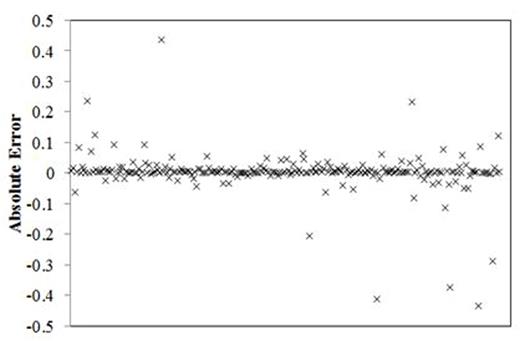Abstract

Background: Prediction of venous thrombosis recurrence is still a challenge. Vienna and Dash scores are widely used for this task, however its results represent only a percentage risk and does not considerate several factors that may influence recurrent thrombosis. In this context, artificial neural networks (ANN) could be a powerful tool to relate the clinical and laboratorial parameters with the risk of venous thrombosis recurrence.
Aims: To obtain a ANN model which calculate whenever a patient may have rethrombosis based in his clinical and laboratorial parameters.
Methods: Data of 240 patients with a history of Deep Vein Thrombosis (DVT) were included until one year after the thrombotic episode. Forty four clinical and laboratorial parameters were considered: gender, age, site of thrombosis, pulmonary embolism, proximal or distal lower limb thrombosis, provoked or unprovoked thrombosis, D-dimer, FV Leiden, G20210A prothrombin gene mutation, factor VIII, protein C, protein S, antithrombin, lupus anticoagulant, anticardiolipin, anti β2-GPI, antiphospholipid syndrome, body mass index, tabagism, hormonal therapy (for women), hemogram (leukocyte, platelet, hemoglobin, erythrocyte, hematocrit, RDW, MPV), HDL and LDL cholesterol, triglycerides, glycemia, creatinine, C-reative protein, diabetes mellitus, arterial hypertension, dyslipidemia, liver and/or renal failure, cancer, residual venous thrombus on US doppler, sickle-cell disease, anticoagulant treatment including drug and duration. All these variables were used as ANN inputs. The occurrence (or not) of rethrombosis was used as output in a yes/no (1/-1) form. The data were randomly divided into train (60 %), test (15 %), and validation (15 %) data. ANNs with one and two hidden layers were tested. The number of neurons varied from 5 to 35 at the first hidden layer and from 5 to 20 at the second hidden layer. ANNs were trained using the Powell method, minimizing the sum of quadratic errors between the calculated and the experimental response.
Results: The ANN that gave the best result contained 44 neurons in the input layer, 5 neurons in the intermediate layer and 1 neuron in the output layer. Figure 1 shows the correlation between the calculated and the experimental outputs, which are very high. The overall model correlation was 0,97. Figure 2 confirms this result: the absolute error between the experimental and the calculated value is very low, and are very near to zero in most cases. The mean average deviation obtained was 2.5 %.
Conclusions: Our results suggest that using a set of clinical and laboratorial data to construct an ANN model could be an efficient tool to predict the recurrence of venous thrombosis. This finding must be repeated in the same group of study including a higher number of patients, and be validate in other populations to be used in clinical practice. We also intend to select the variables that could be related to recurrence of venous episode.
No relevant conflicts of interest to declare.
Author notes
Asterisk with author names denotes non-ASH members.

This icon denotes a clinically relevant abstract



This feature is available to Subscribers Only
Sign In or Create an Account Close Modal